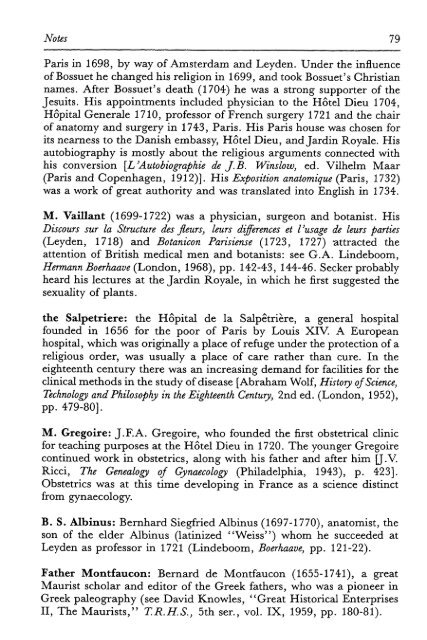Archbishop of Canterbury - KU ScholarWorks - The University of ...
Archbishop of Canterbury - KU ScholarWorks - The University of ...
Archbishop of Canterbury - KU ScholarWorks - The University of ...
Create successful ePaper yourself
Turn your PDF publications into a flip-book with our unique Google optimized e-Paper software.
Notes 79<br />
Paris in 1698, by way <strong>of</strong> Amsterdam and Leyden. Under the influence<br />
<strong>of</strong> Bossuet he changed his religion in 1699, and took Bossuet's Christian<br />
names. After Bossuet's death (1704) he was a strong supporter <strong>of</strong> the<br />
Jesuits. His appointments included physician to the Hotel Dieu 1704,<br />
Hopital Generale 1710, pr<strong>of</strong>essor <strong>of</strong> French surgery 1721 and the chair<br />
<strong>of</strong> anatomy and surgery in 1743, Paris. His Paris house was chosen for<br />
its nearness to the Danish embassy, Hotel Dieu, and Jardin Royale. His<br />
autobiography is mostly about the religious arguments connected with<br />
his conversion [L'Autobiographie de J.B. Winslow, ed. Vilhelm Maar<br />
(Paris and Copenhagen, 1912)]. His Exposition anatomique (Paris, 1732)<br />
was a work <strong>of</strong> great authority and was translated into English in 1734.<br />
M. Vaxllant (1699-1722) was a physician, surgeon and botanist. His<br />
Discours sur la Structure des fleurs, leurs differences et Vusage de leurs parties<br />
(Leyden, 1718) and Botanicon Parisiense (1723, 1727) attracted the<br />
attention <strong>of</strong> British medical men and botanists: see G.A. Lindeboom,<br />
Hermann Boerhaave (London, 1968), pp. 142-43, 144-46. Seeker probably<br />
heard his lectures at the Jardin Royale, in which he first suggested the<br />
sexuality <strong>of</strong> plants.<br />
the Salpetriere: the Hopital de la Salpetriere, a general hospital<br />
founded in 1656 for the poor <strong>of</strong> Paris by Louis XIV. A European<br />
hospital, which was originally a place <strong>of</strong> refuge under the protection <strong>of</strong> a<br />
religious order, was usually a place <strong>of</strong> care rather than cure. In the<br />
eighteenth century there was an increasing demand for facilities for the<br />
clinical methods in the study <strong>of</strong> disease [Abraham Wolf, History <strong>of</strong> Science,<br />
Technology and Philosophy in the Eighteenth Century, 2nd ed. (London, 1952),<br />
pp. 479-80].<br />
M. Gregoire: J.F.A. Gregoire, who founded the first obstetrical clinic<br />
for teaching purposes at the Hotel Dieu in 1720. <strong>The</strong> younger Gregoire<br />
continued work in obstetrics, along with his father and after him Q.V.<br />
Ricci, <strong>The</strong> Genealogy <strong>of</strong> Gynaecology (Philadelphia, 1943), p. 423].<br />
Obstetrics was at this time developing in France as a science distinct<br />
from gynaecology.<br />
B. S. Albinus: Bernhard Siegfried Albinus (1697-1770), anatomist, the<br />
son <strong>of</strong> the elder Albinus (latinized "Weiss") whom he succeeded at<br />
Leyden as pr<strong>of</strong>essor in 1721 (Lindeboom, Boerhaave, pp. 121-22).<br />
Father Montfaucon: Bernard de Montfaucon (1655-1741), a great<br />
Maurist scholar and editor <strong>of</strong> the Greek fathers, who was a pioneer in<br />
Greek paleography (see David Knowles, "Great Historical Enterprises<br />
II, <strong>The</strong> Maurists," T.R.H.S., 5th ser., vol. IX, 1959, pp. 180-81).

















